FXOpen
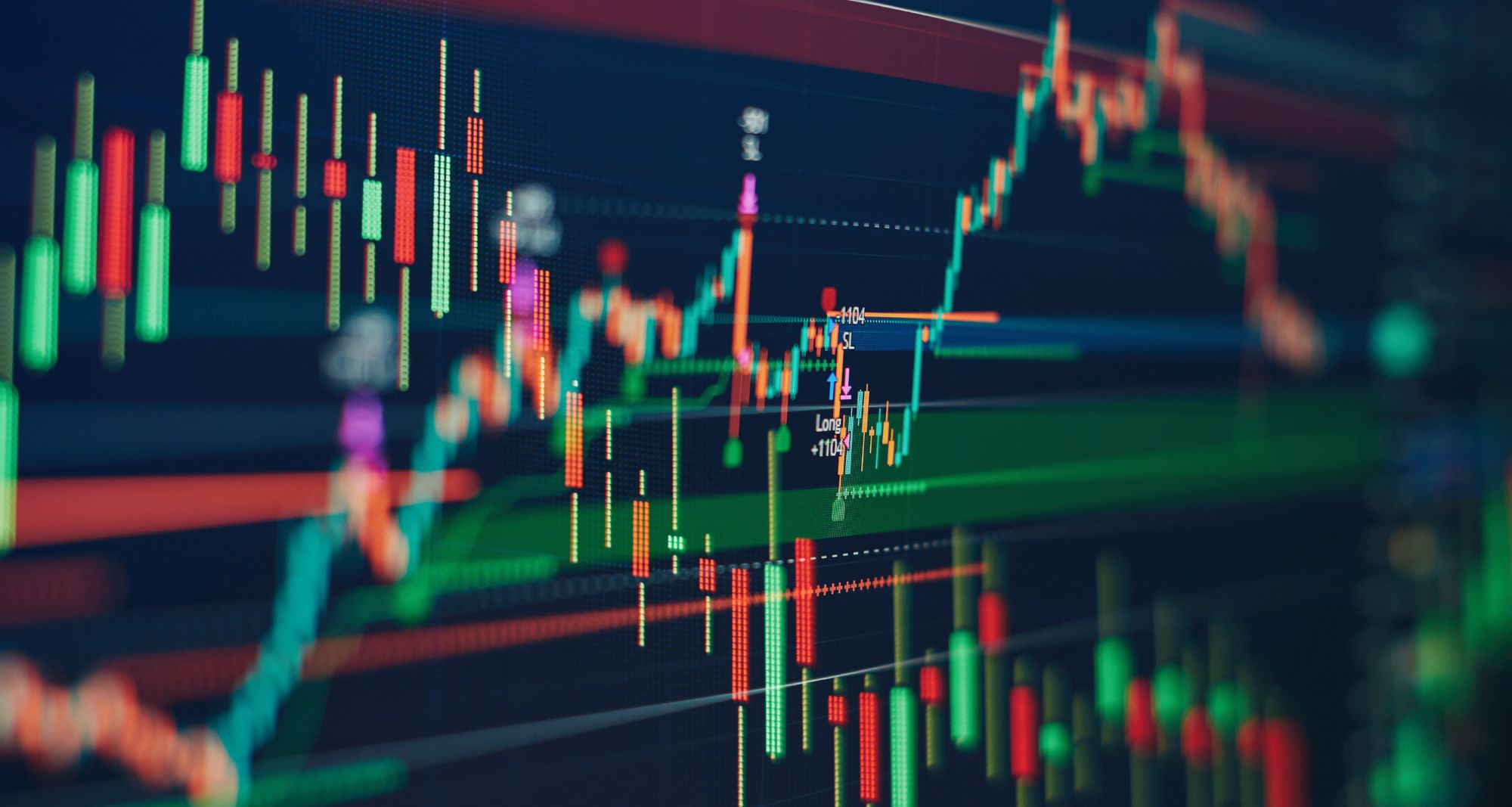
The Wyckoff method is a popular technique for analysing market trends, finding reversals, and making informed trading decisions. In this article, we’ll provide an overview of this decades-old system and explain how you may apply it to your strategy.
What Is the Wyckoff Method?
The Wyckoff method is a type of technical analysis developed in the early 20th century by Richard D. Wyckoff, a renowned stock market trader and analyst. The method is based on the belief that markets are driven by fundamental supply and demand forces and that these forces can be traded through repeatable patterns.
The Wyckoff methodology offers traders a comprehensive system that gives them all the tools they need to create a potentially successful trading strategy. This system includes the relationship between price and volume, the identification of market structure, and the role liquidity plays in financial markets.
The Market Cycle
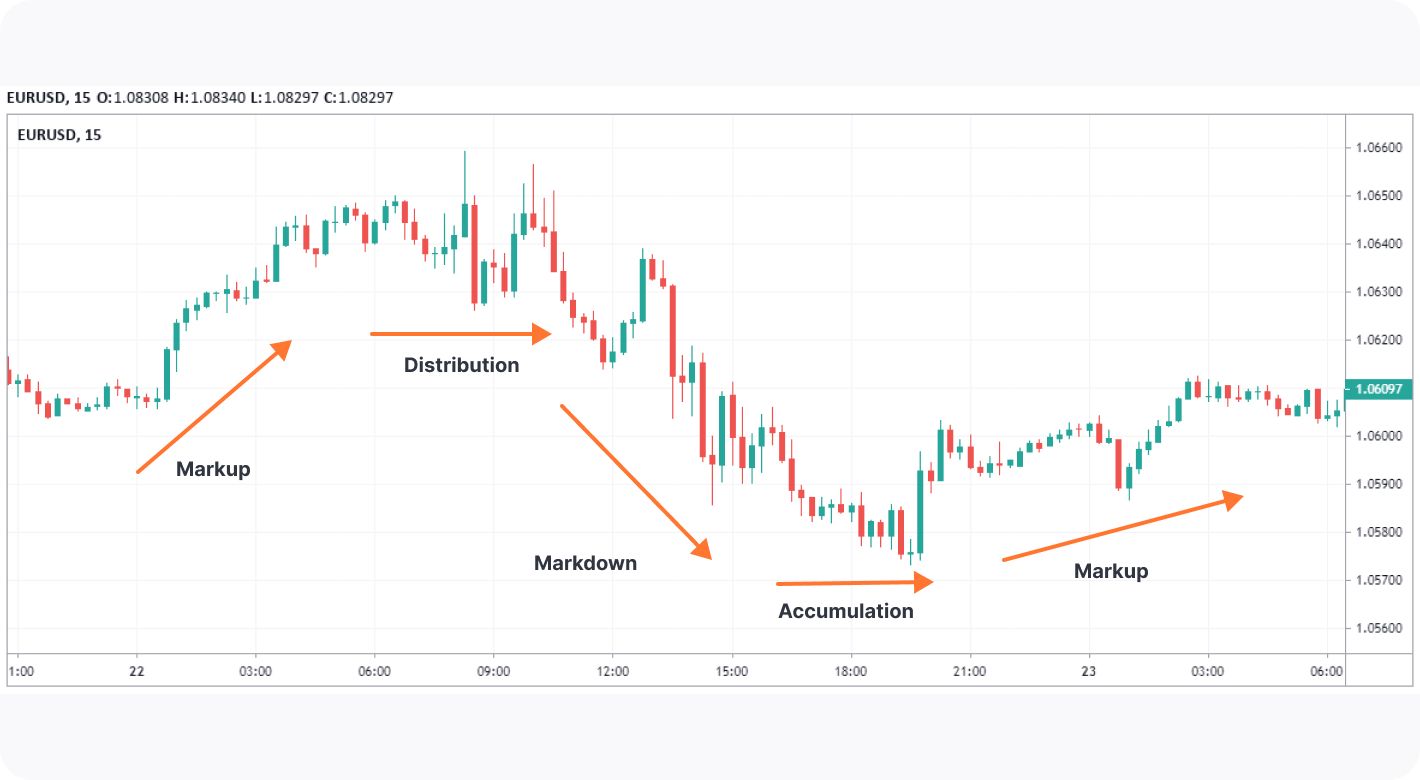
The Wyckoff methodology frames the markets in four repeated phases. These are accumulations, markups, distributions, and markdowns.
Accumulations
Most often seen in ranges, accumulations represent areas where large players are building up a position to go long before the market reveals its true direction to other traders.
Markups
Once they hold a large enough position, these players start to bid the price up, encouraging other traders to jump in and push the price up further. This self-reinforcing cycle of more and more traders getting involved causes the price to shoot up out of the range and begin an uptrend. Note that a markup may have multiple re-accumulations where it pauses and consolidates before breaking higher.
Distributions
Once the price reaches its target and the buying pressure from other traders subsides, the big players will begin to distribute (sell) their positions while building up shorts. This will, again, look like a range before a sharp move down.
Markdowns
This sharp move down is known as the markdown. It’s essentially the opposite of a markup: financial institutions push the price down and encourage traders to enter short positions to begin a downtrend. Like markups, there are also phases of redistribution that consolidate before moving lower.
Why the Wyckoff Model Works
To fill big trades, financial institutions require a counterparty like everyone else, i.e., a seller if they want to buy, and vice versa. But when you’re trading billions of dollars at any one time, how do you fill your order at an optimal price without slippage?
Enter stop losses and breakout trades. These “smart money” players know that there are stop losses above and below equal highs/lows, trendlines, and support and resistance levels that may facilitate their trades. There are also traders waiting to get in on the breakout.
They realise there is liquidity above and below these levels ready to be used to fill their orders. By pushing prices past these levels and playing on retail traders' emotions, they may get in without risking millions of dollars trying to get their orders filled at suboptimal prices. This is the fundamental idea behind the Wyckoff theory in forex, commodities, crypto, stocks, and more.
Key Principles of the Richard D. Wyckoff Method
There are a few fundamental principles of the Wyckoff methodology that are critical to your understanding: the Composite Man and the three laws.
Composite Man
The Composite Man is the idea that traders should imagine that just one party controls the markets and that they should study them as such. He is, in essence, the “smart money.” Wyckoff believed that the Composite Man carefully plans and executes his trades, encouraging buyers (or sellers) only after he has accumulated a sizable position.
The Law of Supply and Demand
Simply put, if the demand for an asset is greater than its supply, prices will rise. On the other hand, if the supply of an asset is greater than its demand, prices will decrease.
The Law of Cause and Effect
This law states that the dynamics of supply and demand are determined by specific Wyckoff events (the cause), like accumulations and distributions. It also says that the effect, or the price movements, are proportional to the cause. An accumulation that occurs on the daily timeframe will produce a much more significant effect than one on the 1 minute, for instance.
The Law of Effort vs. Results
This law says that price movements are a result of effort, characterised by volume. If a bullish trend is supported by strong volume, it will likely continue. Moreover, if a trading range has a high volume but remains consolidated (a minor result), a potential trend reversal could be about to start.
Wyckoff Schematics
While this might sound like a lot to take in, it’s relatively easy to spot using the time-tested Wyckoff chart patterns. If you want to test your own understanding, you may use the TickTrader terminal with us at FXOpen. It’s completely free to use, with no signup required if you don’t plan to open trades but just want to examine what patterns look like on the chart.
Note that Wyckoff accumulations and distributions are practically identical, just flipped upside down. The key concepts, points, and phases are all the same.
Type 1 Schematics
Accumulations
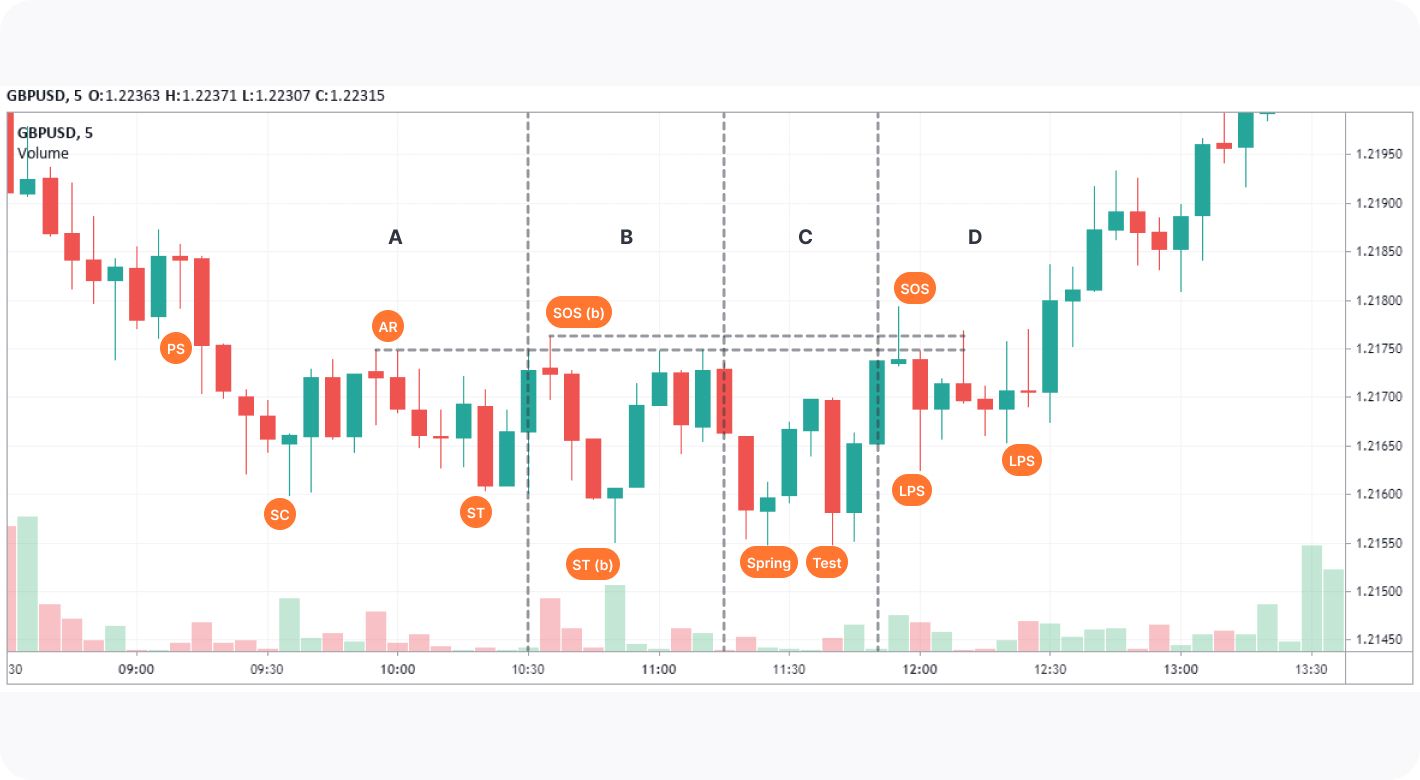
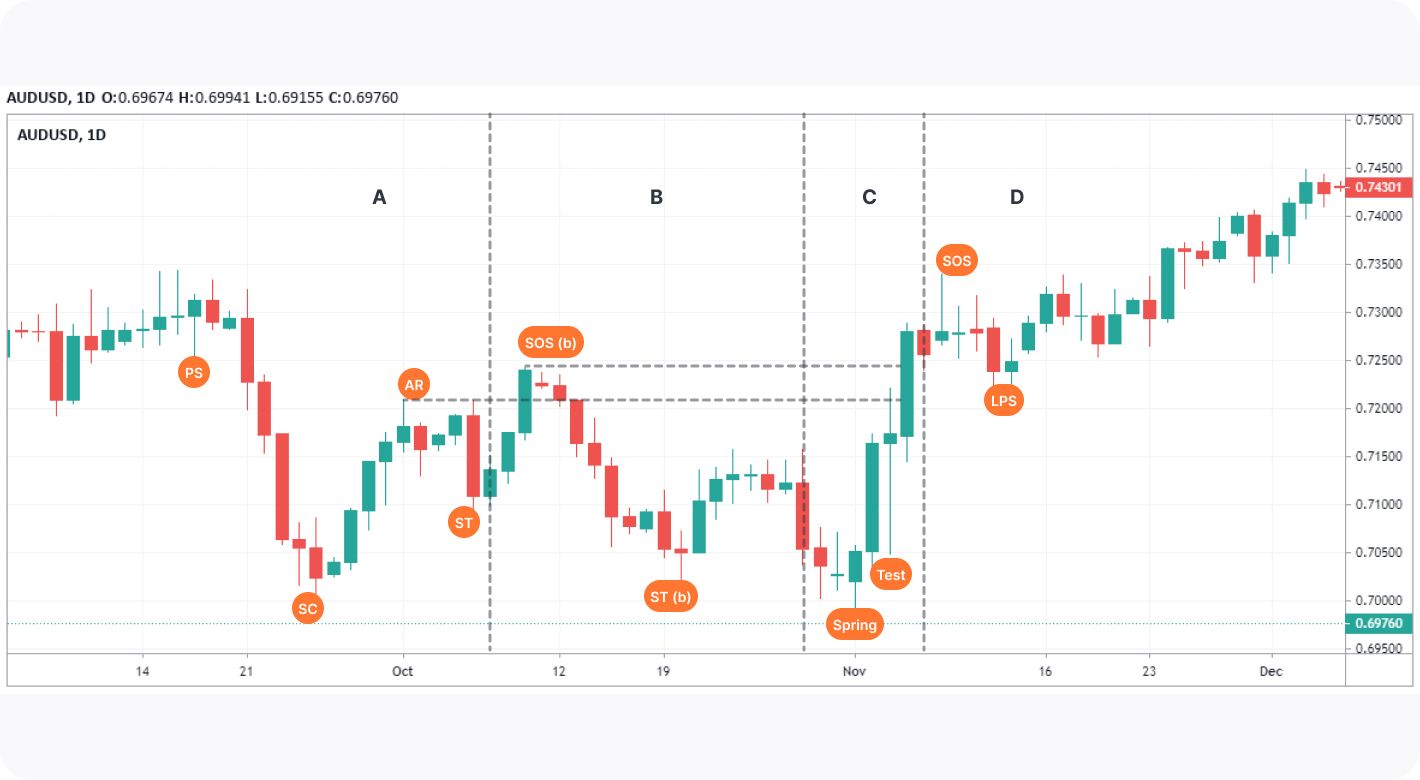
Phase A
- Preliminary Support (PS): After a markdown, buying action interrupts the downtrend and causes a slight uptick in price. Volume increases.
- Selling Climax (SC): Long traders have their stop losses triggered, while breakout traders jump in short, believing the downtrend will continue. Here, the Composite Man absorbs the selling pressure. The SC may sometimes leave a long wick that shows the buying pressure.
- Automatic Rally (AR): Given that selling pressure is exhausted, buy orders push prices up easily, and shorts exit their trades, typically below PS. Note that the high of the AR sets the first upper bound for the accumulation.
- Secondary Test (ST): The price falls from the AR to form a low near the SC, creating the ST. It can create equal lows or end up slightly higher or lower than the SC. This may also occur multiple times, creating a visual area of support. Volume is likely to be low.
Phase B
- Sign of Strength in Phase B (SOS(b)): After the ST, the price can rebound higher than the AR, forming the SOS(b). This won’t always occur, but if it does, it creates our second upper bound. Again, it is supposed to fall below the PS.
- Secondary Test in Phase B (ST(b)): This is the first “liquidation” event of the accumulation. A sharp move downward takes out the ST and, ideally, the SC. Here, the Composite Man taps into the stop losses below the ST and breakout sell orders to fill his buy orders, creating the Cause.
Phase C
- Spring: Following the ST(b), the price will likely test the first and second upper bounds, but it is supposed to always stay within them. After doing so, the Composite Man will push the price down for the last time below the ST(b), liquidating any orders resting below here to form the Spring.
- Test: After creating the Spring, the Composite Man will often test the area to see if there’s any supply left. The price will create a higher low near the Spring, often with lower volume. Note that there can be multiple tests.
Phase D
- Last Point of Support (LPS): Following the test and another leg higher, the price will pull back to test supply once again. LPSs are usually much higher than the initial Tests, and are often the last move before the markup begins. LPSs can form both before and after the SOS, depending on how the price action plays out.
- Sign of Strength (SOS): Here, the price breaks above the highest upper bound and confirms the schematic, often with higher volume. As mentioned, the LPS can form after the breakout and fall back in the range or test the upper resistance line. After the SOS forms, the markup begins and produces the Effect as seen in the Wyckoff accumulation chart above.
Distributions
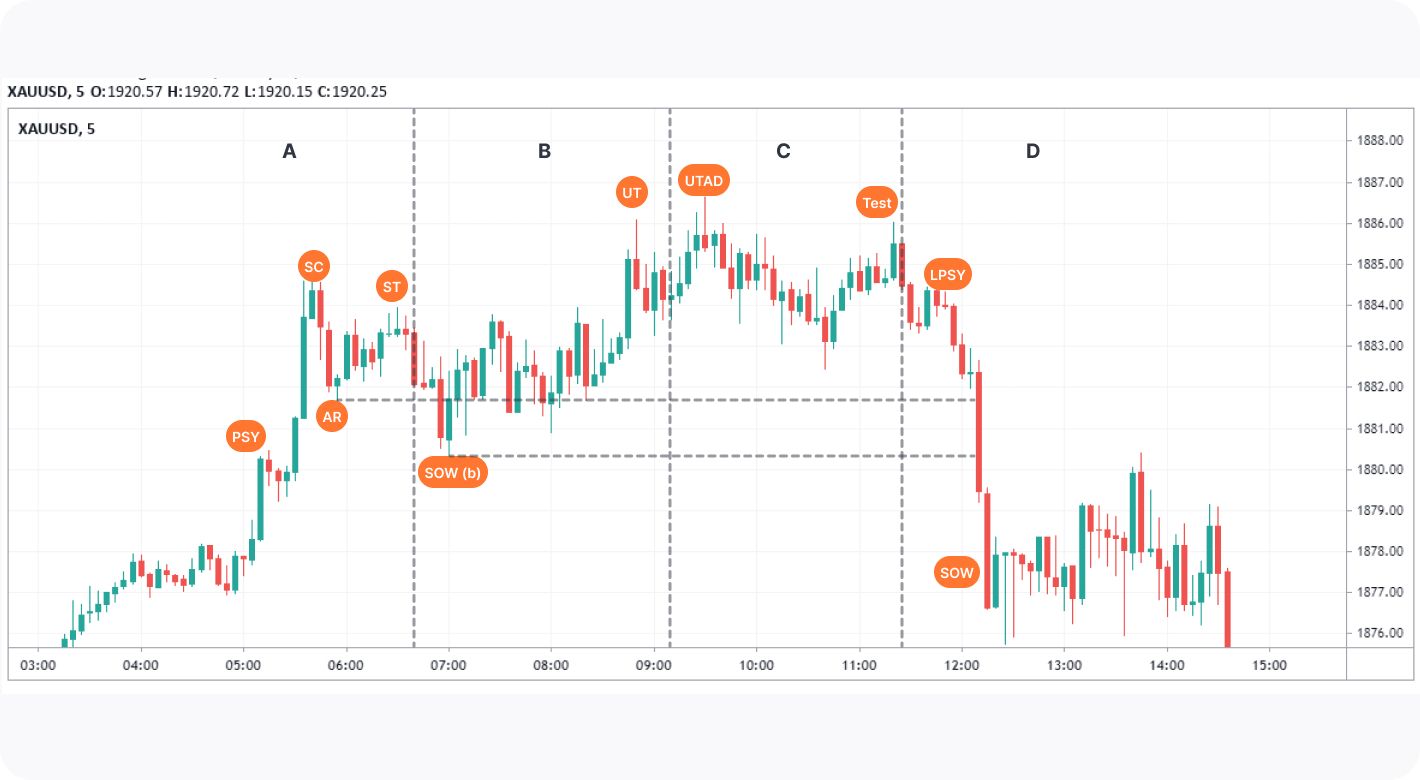
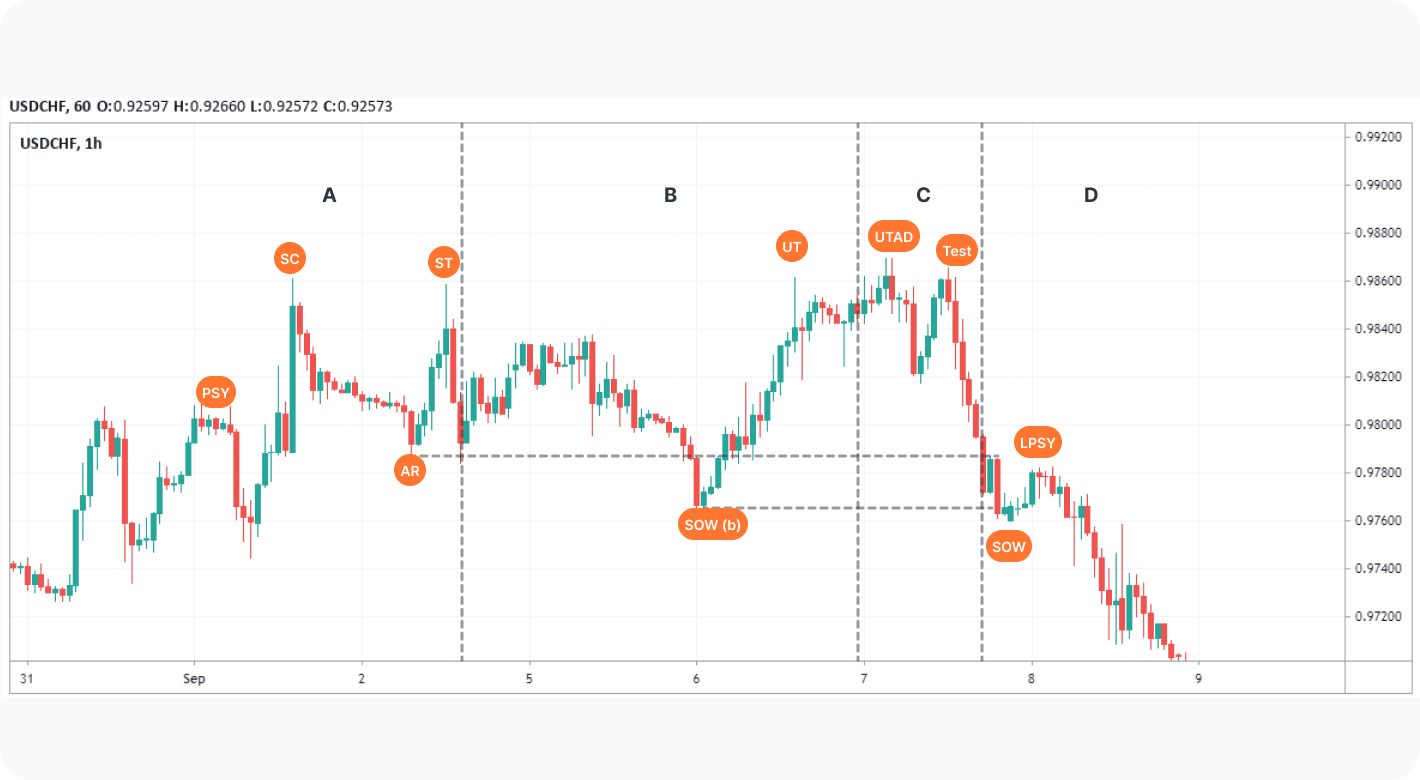
Phase A
- Preliminary Supply (PSY): After an uptrend, the Composite Man begins to unload his position, causing the price to fall slightly.
- Buying Climax (BC): Like the SC, the BC is where buying pressure is at its most extreme, coinciding with high volume.
- Automatic Rally (AR): After buying subsidies, prices fall to form the AR, usually above the PSY. This is our first lower bound.
- Secondary Test (ST): The price revisits the BC area to create another high usually below the BC, building up liquidity for future phases. The volume should be low.
Phase B
- Sign of Weakness in Phase B (SOW(b)): A move down past the AR that indicates supply is entering the market. Like the SOS(b), the SOW(b) doesn’t always occur, but if it does, it forms our second lower bound.
- Upthrust (UT): This is the distribution equivalent of a ST(b). It must reach higher than the ST and may take out the BC. Here, the Composite Man uses short stop losses and breakout trades to fill his sell orders.
Phase C
- Upthrust After Distribution (UTAD): The UTAD is analogous to an accumulation’s Spring. Following the UT, one last tap into areas of liquidity is made before the markdown.
- Test: Similar to accumulation, there are usually one or more tests made near the UTAD attempting to see if any demand remains.
Phase D
- Last Point of Supply (LPSY): After the price declines, the final tests of demand are made. Like accumulations, these points can occur before or after the Sign of Weakness. They’re typically the last bullish moves made before the markdown begins.
- Sign of Weakness (SOW): The lowest bound is broken as the price begins to confirm its bearish structure. Another LPSY can be made, but this is the final step before the markdown.
Type 2 Schematics
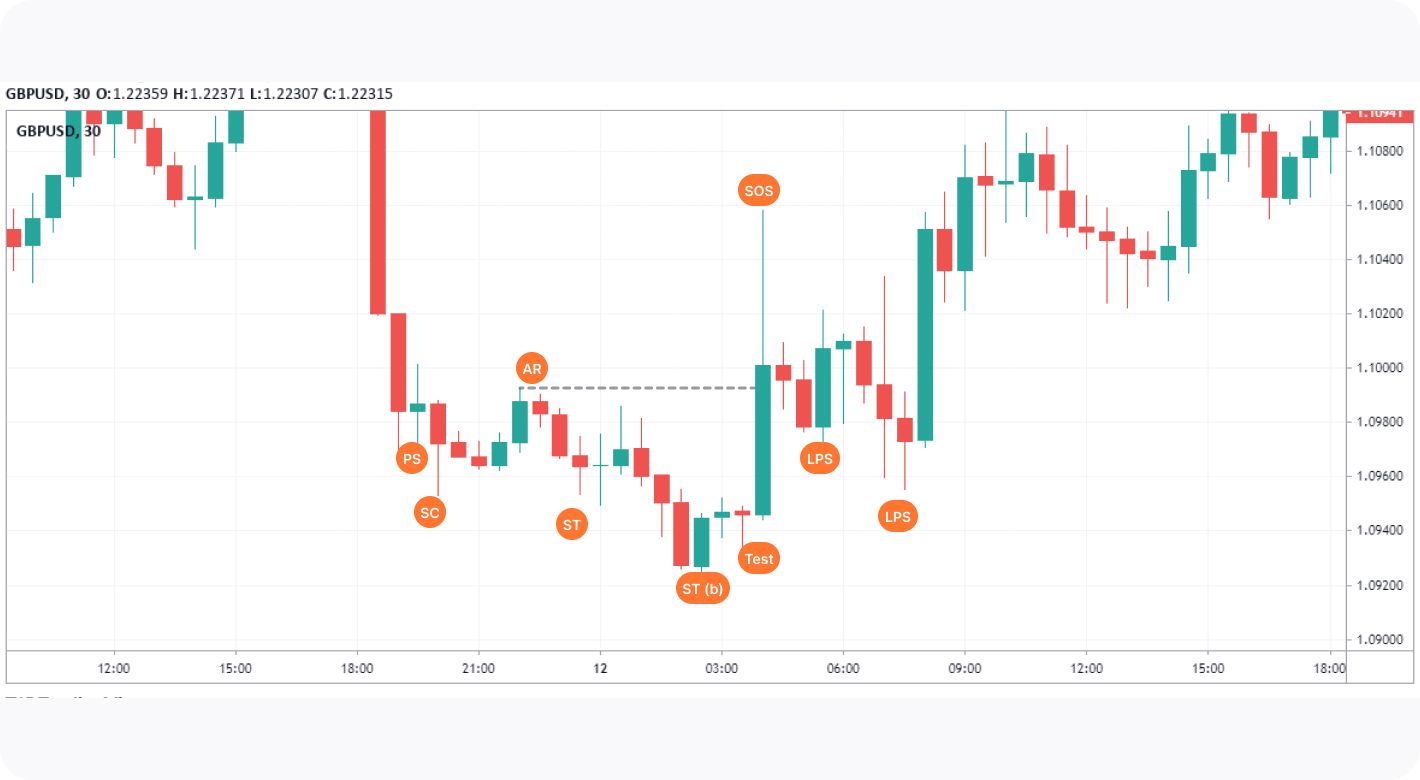
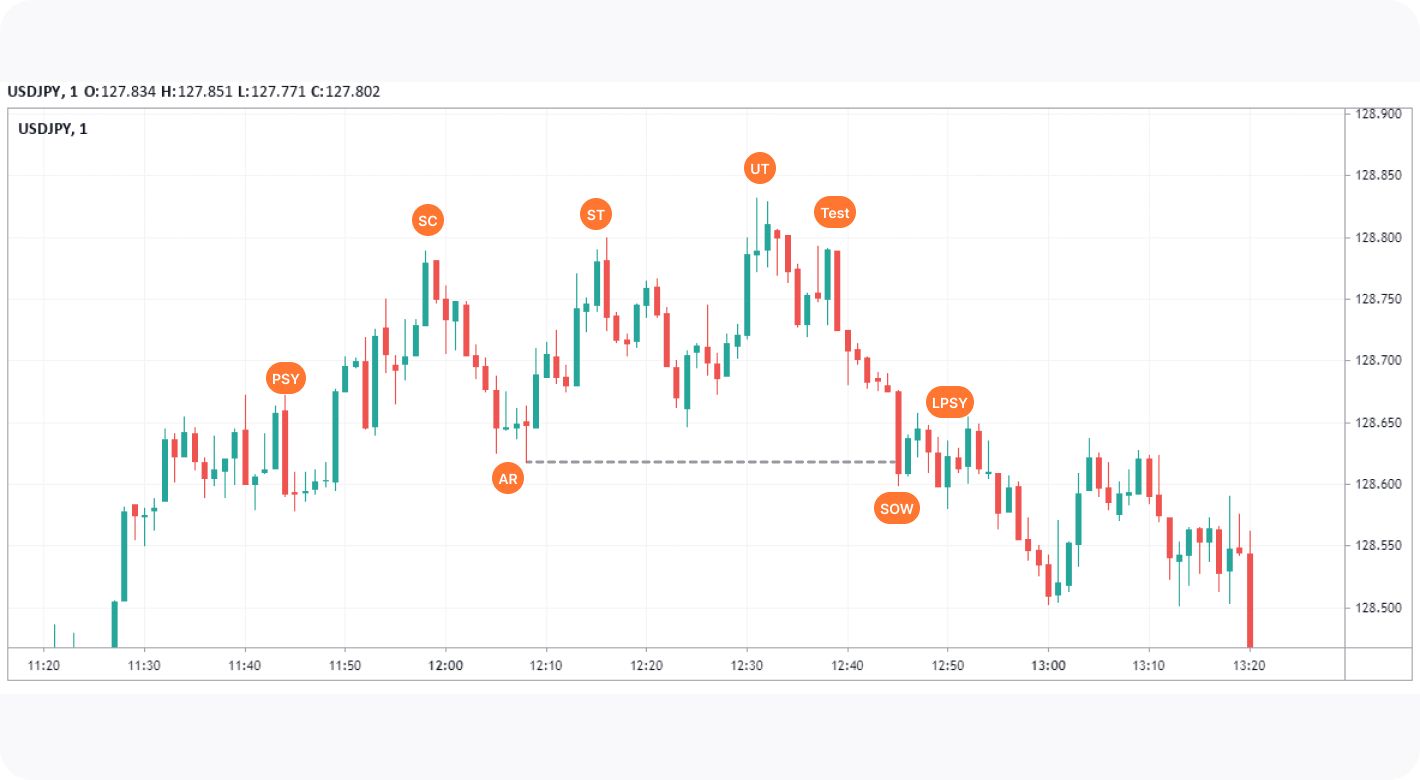
Type 2 Wyckoff schematics have all of the same ingredients, just without a Spring or UTAD. How do you know if what you’re looking at is a Type 2 schematic? Just wait for the SOS or SOW to occur. If you have just a single ST and an ST(b), or an ST and UT, and the markup or markdown begins, you know it’s a Type 2. This is seen in the Wyckoff graph above. Both can be traded in the same ways as a Type 1.
The Five-Step Wyckoff Trading Strategy
Luckily for us, Wyckoff developed a five-step strategy for using his methodology. This could be used to create your own Wyckoff forex trading strategy.
- Determine the current market trend. Assess whether the overall market is bullish or bearish.
- Choose your market. Find a pair that strongly correlates to this overall trend.
- Find a pair currently undergoing accumulation or distribution.
- Determine the pair’s readiness to move. This involves examining the Wyckoff phase of the asset and volume. If a Spring or UTAD has just occurred, you could consider it viable.
- Find your entry. Traders often enter on Tests or LPS/LPSYs.
Does the Wyckoff Method Work?
Despite nearly being a century old, Wyckoff’s logic in forex trading has helped traders around the world to develop trading strategies. It may form the basis of an effective strategy when combined with other types of technical analysis, such as harmonic patterns, indicators, and support/resistance. You may consider opening an FXOpen account today to start putting your knowledge to work.
This article represents the opinion of the Companies operating under the FXOpen brand only. It is not to be construed as an offer, solicitation, or recommendation with respect to products and services provided by the Companies operating under the FXOpen brand, nor is it to be considered financial advice.
Stay ahead of the market!
Subscribe now to our mailing list and receive the latest market news and insights delivered directly to your inbox.








